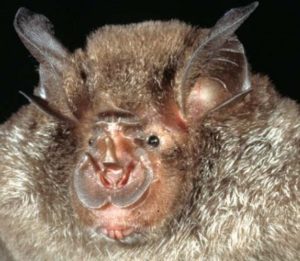It is well past the time to stop blaming a laboratory in China for the release of SARS-CoV-2. Such fallacies reflect an ignorance of scientific facts, including the recent finding of closely related coronaviruses in bats in Thailand.
The bat CoV RatG13, sampled in 2013 in Yunnan province, shares 96% whole genome identity with SARS-CoV-2, suggesting a likely bat origin of the pandemic virus. To identify other possible sources for highly related viruses, a colony of 300 bats in eastern Thailand, consisting only of one species, Rhinolophus acuminatus, was sampled in June 2020. Thirteen of 100 bat rectal swab samples were positive for a single PCR amplicon with 95.86% sequence identity to SARS-CoV-2 and 96.21% identity to bat CoV-RaTG13. This virus, named RacCS203, appears to be the dominant coronavirus circulating in this bat colony. Phylogenetic analyses indicate that RacCS203 is a new member of the SARS-CoV-2 related CoV lineage (SC2r-CoV).
Phylogenetic analyses of the spike receptor binding domain, and binding studies with purified recombinant proteins indicate that RacCS203 does not bind to ACE2 for entry into cells. This conclusion was confirmed by the finding that a pseudotyped VSV virus with the spike gene of RacCS203 cannot infect VeroE6 cells, while VSV with the spike gene of SARS-CoV-2 does infect these cells.
A surrogate virus neutralization test was used to measure antibodies in sera from the sampled bats that block binding of the SARS-CoV-2 receptor binding domain (RBD) to recombinant ACE2. Of 98 bat sera tested, four contained antibodies that block this ligand-receptor interaction. One of ten sera from pangolins also contained antibodies that block the SARS-CoV-2 RBD-ACE2 interaction. These pangolins were confiscated from illegal traders in Central and Southern Thailand are are of unknown origin.
The spike protein of RacCS203 is most similar to the same protein from the bat isolate RmYN02. Both share part of the furin cleavage site and the RBDs differ by just two amino acids. Sera from COVID-19 patients react strongly with the RBDs of SARS-CoV-2 and RaTG13, and weakly with RmYN02. Rabbit antibodies against the RBDs of RmYN02 and RaTG13 neutralized SARS-CoV-2.
These findings provide further support that SC2r-CoVs are not limited to China. Such viruses have also been detected in bats from the north of Japan, the eastern and southwestern parts of China, and Thailand, a distance of 4800 km. Many more SC2r-CoVs are likely to be found in Rhinolophus bats once surveillance in this region is increased. Such activities are likely to identify the immediate progenitor of SARS-CoV-2, the equivalent of the >99% identical SARS-CoV genomes found in palm civets in 2003.


Great paper. The Lancang River in Yunnan province becomes the Mekong in South East Asia. Yunnan’s capital city of Kunming is a transportation hub connected to Wuhan and other major Chinese cities. I suspect that the bats and nocturnal arboreal mammals (palm civets, pangolins, and racoon dogs) can be found in the same trees at night throughout this region/ecosystem. In addition to China and northern Thailand, Laos and Vietnam (along the Mekong) should be considered ground-zero for these SC2r-CoVs, in my opinion.
Pingback: SARS-like bat coronaviruses are not only in China – Psychiatry Intel – Real-Time Evidence-Based Psychiatry and Mental Health Research Online
Have any local people who have lived in the same regions as these bats for generations developed a level of immunity from periodic exposure to the viruses in question?
The original post is based on a fallacy. The percentage of shared genes is irrelevant. Humans and chimpanzees share almost 99 percent of their genome. So what? All the original post proves is that the lab used bat coronavirus for its research. Show me that no one could create SARS2 from bat coronavirus because it is not technologically possible. Show me that the lab didn’t have the technological expertise to create SARS2 from bat coronavirus. Otherwise, the OP is based on speculation or possibly secondary gain.
This is a great study. We need a lot more of these! Hopefully soon, we’ll have a better inventory of related betacoronaviruses and be able to build a more complete family tree, and track down the origin and the spillover event.
One point about the impact of this on the lab escape conjecture: This study increases the chance we’ll find a natural origin for SARS-CoV-2, but doesn’t do much to debunk the lab escape idea. This is because such labs research naturally-occurring viruses all the time, including those that have pandemic potential. The chance that SARS-CoV-2 entered the human population via some kind of error made in the Wuhan lab is unchanged by this research.
So, we can group the competing ideas as follows:
a) lab escape versus zoonotic spillover event, and
b) modified virus versus naturally-occurring virus.
While they are related, they are two separate arguments, and evidence that impacts one may not necessarily impact the other.
Cheers!
This study has *some* impact on the chance of the origin turning out to be gain-of-function research, because the more we know about the diversity and distribution of related coronaviruses, the more potential sources and mechanisms we have for recombination events and spillover events.
As far as I know, nobody has looked at how close we can get to SARS-CoV-2 by performing recombinations using its known relatives. This would presumably help narrow things down further.
Anyway, a study like this can’t completely rule out a GoF origin. See:
“The genetic structure of SARSâ€CoVâ€2 does not rule out a laboratory origin”
https://onlinelibrary.wiley.com/doi/10.1002/bies.202000240
(Though their argument about the uniqueness of furin cleavage is now outdated per recent discoveries, their point about the potential of siteâ€directed mutagenesis still seems valid)
Great paper and data provided. I am glad I found your site few months ago-Data, Vicent Racaniello & Co are the only facts I rely on. Thank you